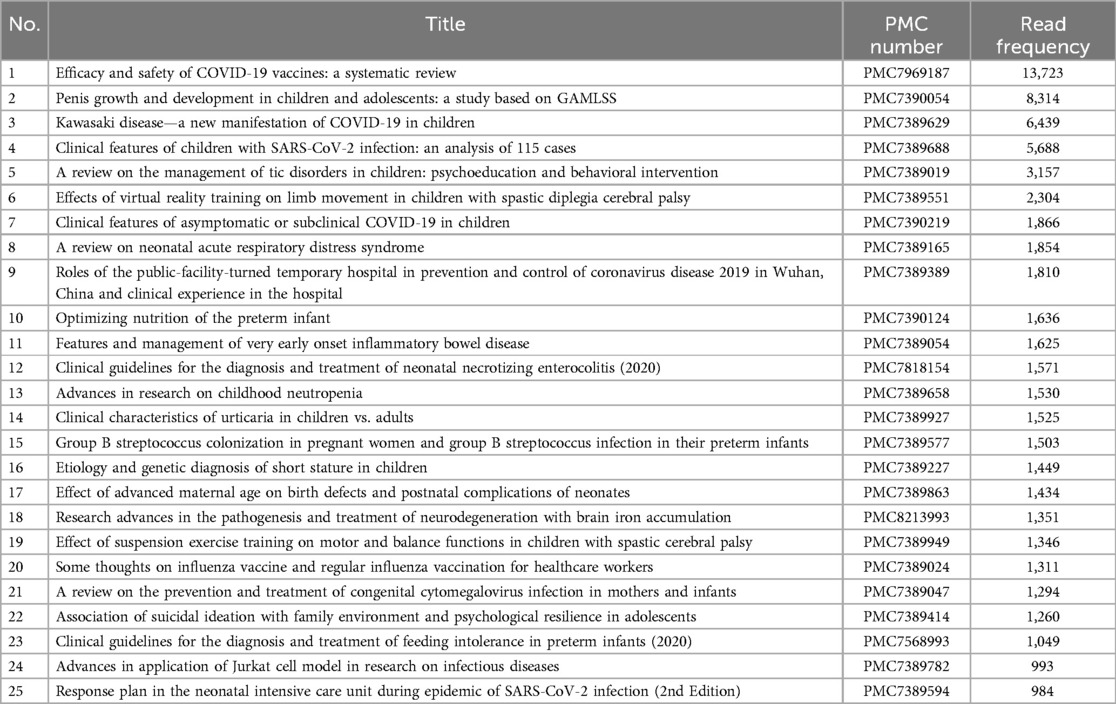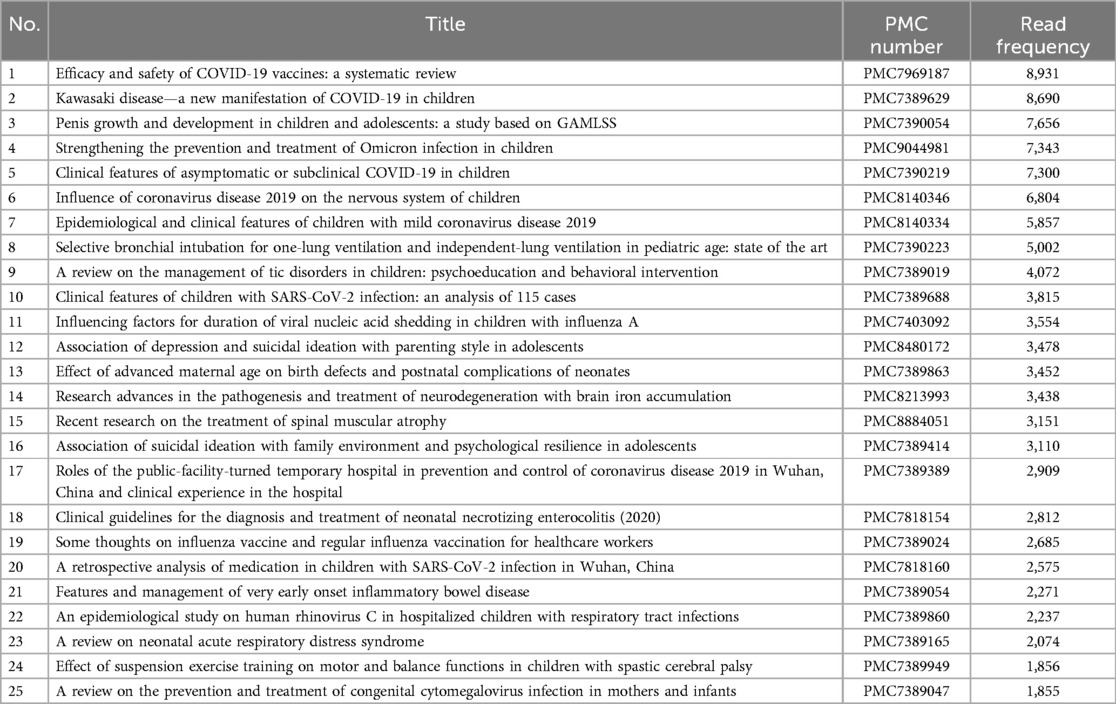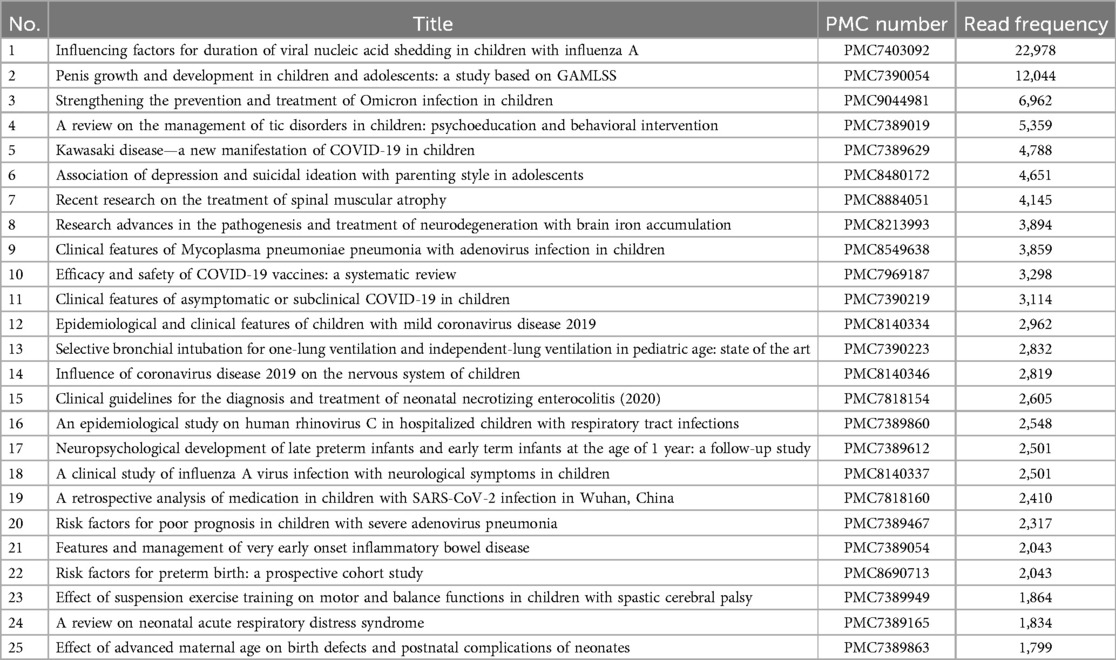- 1Editorial Office of Chinese Journal of Contemporary Pediatrics, Xiangya Medical Academic Promotion Center, Xiangya Hospital, Central South University, Changsha, China
- 2IDMED Research Lab, Beijing Intelligent Decision Medical Technology Co., Ltd., Beijing, China
- 3Xiangya Medical Academic Promotion Center, Xiangya Hospital, Central South University, Changsha, China
Objective: By analyzing high readership articles from the Chinese Journal of Contemporary Pediatrics (CJCP) in the PubMed Central (PMC) database, this study aims to identify research hotspots and trends in the field of pediatrics.
Methods: Articles from the CJCP ranked by annual readership in PMC from 2021 to 2023 were collected. Using word frequency analysis and co-word analysis, the thematic characteristics of these articles were explored.
Results: The word frequency analysis and co-word analysis revealed four thematic directions that were of significant interest to researchers: (1) current public health or medical events such as COVID-19 and influenza; (2) mental health issues in children and adolescents; (3) pediatric neurological diseases and neurodevelopment; (4) diseases in preterm infants and newborns.
Conclusions: This study provides pediatric researchers with a valuable perspective to understand and grasp the development dynamics and future directions in the field of pediatrics.
Introduction
In an increasingly globalized context, the integration of research and practice in pediatrics has led to significant scientific advancements and clinical insights. The Chinese Journal of Contemporary Pediatrics (CJCP) has emerged as a leading platform for disseminating these developments, gaining recognition for its high-quality academic content and practical relevance to pediatric clinicians and researchers worldwide. Since being indexed in MEDLINE (PubMed) in January 2006 and subsequently in PubMed Central (PMC) in August 2020, CJCP's academic stature has grown, with its influence reflected in readership metrics. Currently, the journal receives over 70,000 monthly reads in the PMC database—managed by the National Center for Biotechnology Information in the U.S.—which serves as a crucial resource for free access to biomedical literature.
Despite the vast amount of academic information available, pediatric researchers face challenges in identifying research hotspots and trends. In this era of networked information sharing, the number of downloads and reads post-publication is a valuable indicator of research interest (1). This study analyzes article readership from the CJCP in PMC between 2021 and 2023, employing word frequency and co-word analysis methods to uncover high-readership articles. By systematically sorting and analyzing these articles, we aim to identify key focal points and emerging trends in pediatric research, offering vital references for researchers navigating the evolving landscape of pediatrics.
We now present a detailed analysis of CJCP's high-readership articles from 2021 to 2023.
Methods
Data sources
Data for this study were sourced from the PMC Publisher Statistics platform (https://www.ncbi.nlm.nih.gov/pmc/publisherservices/), which provides network backend access to journal publishers. We extracted the top 25 articles by annual readership from the CJCP publications between 2016 and 2023 for the years 2021 to 2023 (Tables 1–3). The CJCP published a total of 1,784 articles from 2016 to 2023, all of which are available for free reading on PMC. These articles include the number of publications for each year from 2016 to 2023: 252, 246, 204, 226, 232, 208, 216, and 200 articles, respectively.
Word frequency analysis
We conducted word frequency analysis using R software (version 4.1.3). By summarizing and analyzing all the analyzed articles’ MeSH keywords in PubMed, we used the dplyr package (version 1.1.2) for word frequency statistics and ranking, calculating the occurrence frequency of these keywords in the top articles for each year and the total readership of these articles.
Co-word clustering analysis
We used VOSviewer (version 1.6.20) for co-word analysis to extract the main keywords of the high-readership articles and cluster them based on their co-occurrence frequency in the literature. All analyzed articles were imported into VOSviewer in PubMed bibliographic data format, with the minimum co-word occurrence frequency threshold set to 1 and the minimum cluster size set to 10. Other parameters were set to default, generating a keyword co-occurrence network and clustering analysis map.
Results
Evaluation of annual keyword readership patterns
This study analyzed the primary keywords of the top 25 high-readership articles each year from 2021 to 2023, examining the yearly keyword readership trends and visualizing the research hotspots.
2021 high-frequency keyword analysis
As shown in Table 4, “COVID-19” and related themes had the highest readership throughout the year, indicating that the primary research focus in 2021 was the COVID-19 pandemic. Related themes included the epidemiological dynamics of the pandemic, virus testing, treatment, and societal and economic impacts. In addition, primary research evaluated vaccine development including effectiveness, safety andstrategies for implementation.
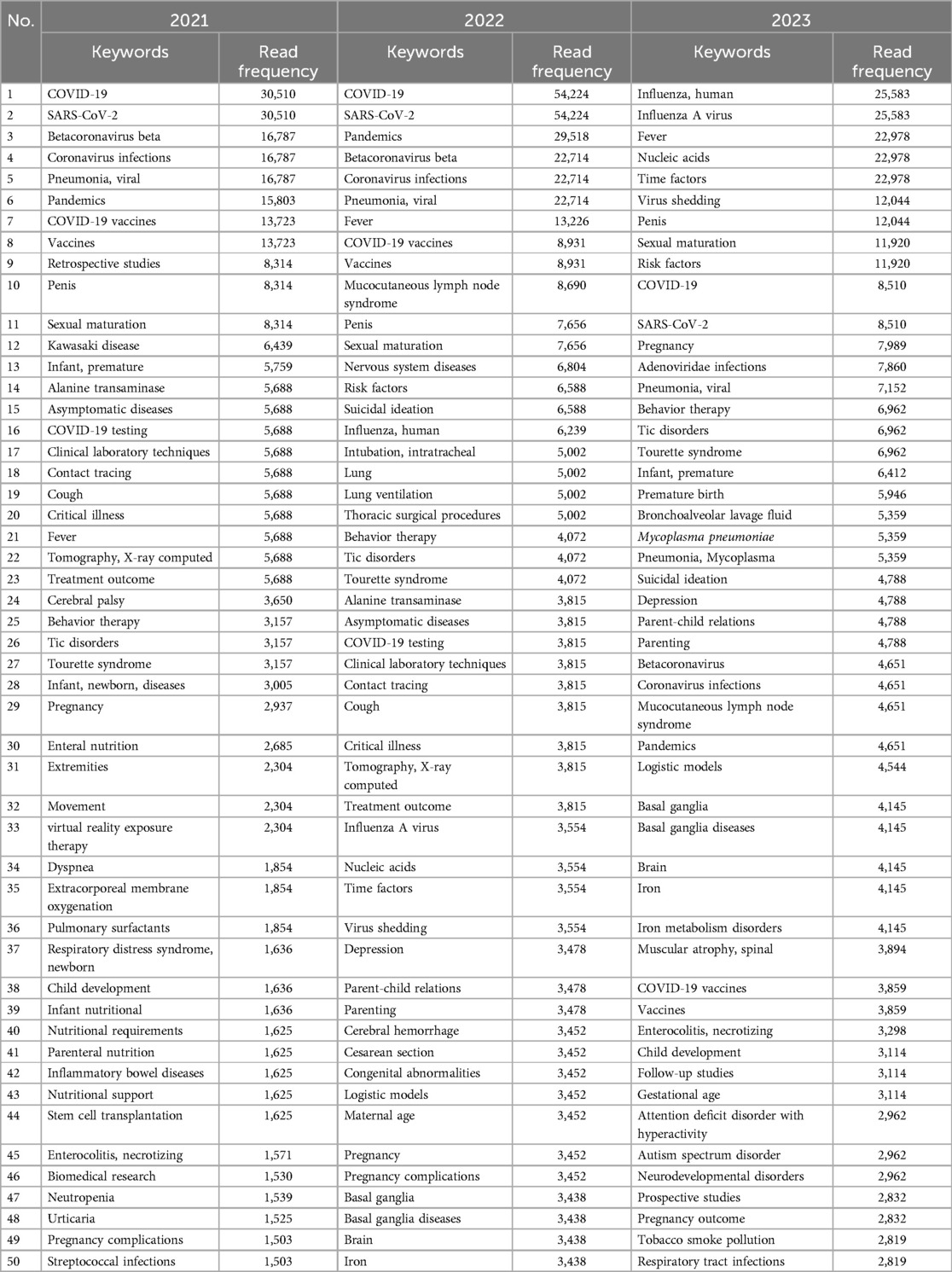
Table 4. Read frequency for articles corresponding to the top 50 popular keywords from 2021 to 2023.
Pediatric and adolescent neurological diseases and behavioral development were significant areas of interest for researchers. Keywords related to “cerebral palsy,” “behavioral therapy,” and “tic disorder” had readerships exceeding 3,000 times.
The management and treatment of diseases in preterm infants and newborns were also focal points. Keywords related to “enteral nutrition,” “parenteral nutrition,” and “nutritional support” in articles about preterm infants and newborns had high readerships, indicating researchers’ attention to the importance of nutrition in the treatment and health maintenance of preterm infants and newborns. Neonatal respiratory diseases were also a hot topic.
Using VOSviewer to construct a keyword co-occurrence network and clustering map, the results were consistent with the descriptive keyword analysis mentioned above (Figure 1).
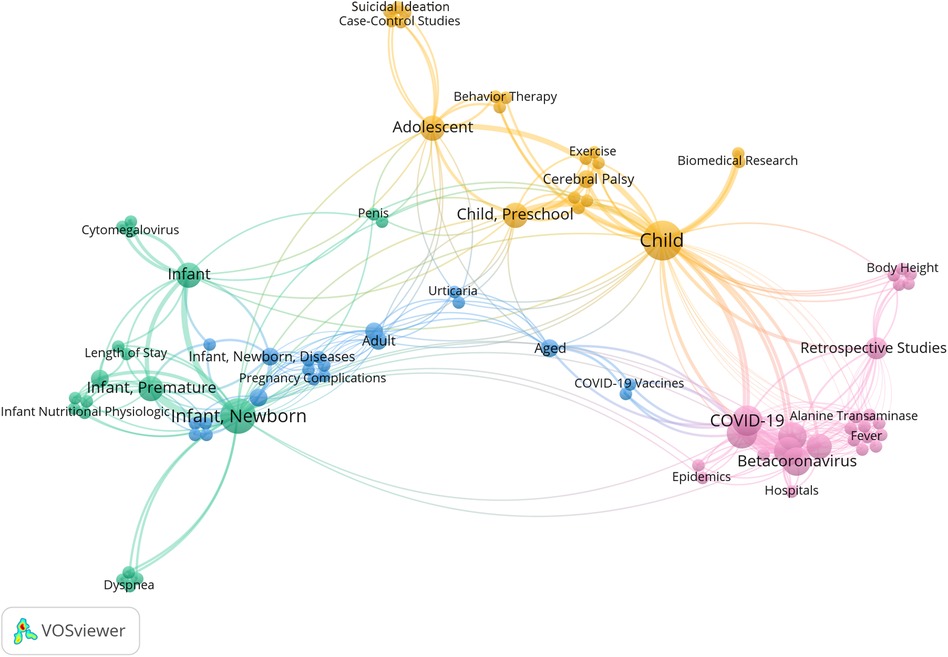
Figure 1. 2021 co-occurrence network and cluster analysis diagram of hot keywords. From the graph, it can be observed that there were mainly four research directions: COVID-19 (in violet-red); pediatric and adolescent neurological diseases and behavioral development (in orange); preterm-related issues (in blue-green); neonatal diseases (in sky-blue).
2022 high-frequency keyword analysis
As shown in Table 4, COVID-19 continued to be a hot topic in 2022: articles with keywords like “COVID-19” and “SARS-CoV-2” had the highest readership, indicating that COVID-19 remained a major focus in 2022. This included the development of the pandemic, virological research, epidemiological investigations, vaccine research and vaccination, and global public health responses. Influenza-related issues also gradually attracted attention.
Articles focusing on mental health and behavioral disorders in children and adolescents continued to garner high readership in 2022. Keywords like “suicidal ideation” and “depression” had readerships exceeding 6,000 and 3,000 times, respectively, highlighting the importance of research on children's mental health and behavioral disorders.
Pediatric neurological diseases and neurodevelopment continued to be highly focused research areas. This included diseases of the nervous system and related behavioral and developmental issues in children, such as autism spectrum disorder and attention deficit hyperactivity disorder.
Keywords like “cesarean section” and “pregnancy complications” also had high readerships, indicating high researcher interest in neonatal and perinatal medicine.
Using VOSviewer to construct a keyword co-occurrence network and clustering map, the results were consistent with the descriptive keyword analysis mentioned above (Figure 2).
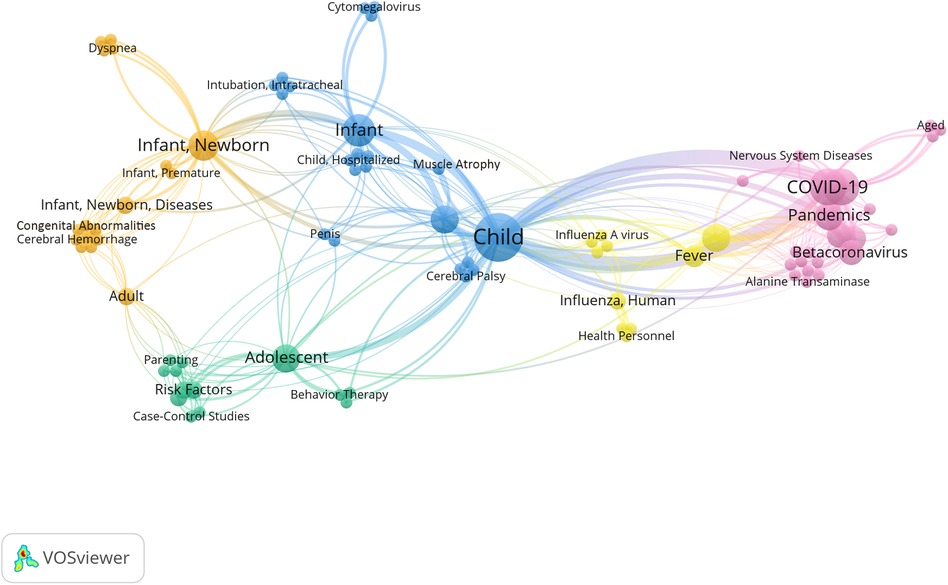
Figure 2. 2022 co-occurrence network and cluster analysis diagram of hot keywords. From the colors and clustering of the keywords in the diagram, it can be observed that there were mainly five research directions: COVID-19 (in violet-red); influenza (in yellow); adolescent mental and behavioral health (in blue-green); pediatric neurological disorders (in sky-blue); neonatal diseases (in orange).”
2023 high-frequency keyword analysis
As shown in Table 4, articles related to “influenza” had the highest readership in 2023, indicating that the primary focus in 2023 had shifted to influenza rather than COVID-19. However, COVID-19 still garnered significant attention, particularly regarding its long-term impacts, new variants, vaccines, and treatments.
Articles related to “risk factor research” had high readerships in 2023, indicating strong interest in disease prevention and management of risk factors in children.
In 2023, articles on “pregnancy-related research” and “preterm infant issues” also had high readerships, showing that pregnancy health, complications, and outcomes, as well as the health and management of preterm infants, were research hotspots.
Furthermore, attention to mental health issues in children and adolescents remained high in 2023, indicating it is a continuously interesting area for researchers.
In addition, in 2023, researchers showed greater attention to pediatric neurological diseases and neurodevelopment than in the previous two years. Keywords such as “tic disorder” and “Tourette syndrome” had higher readerships, and keywords related to neurodevelopmental conditions like “attention deficit hyperactivity disorder” entered the top 50 high-frequency keywords for the year.
Using VOSviewer to construct a keyword co-occurrence network and clustering map, the results were consistent with the descriptive keyword analysis mentioned above (Figure 3).
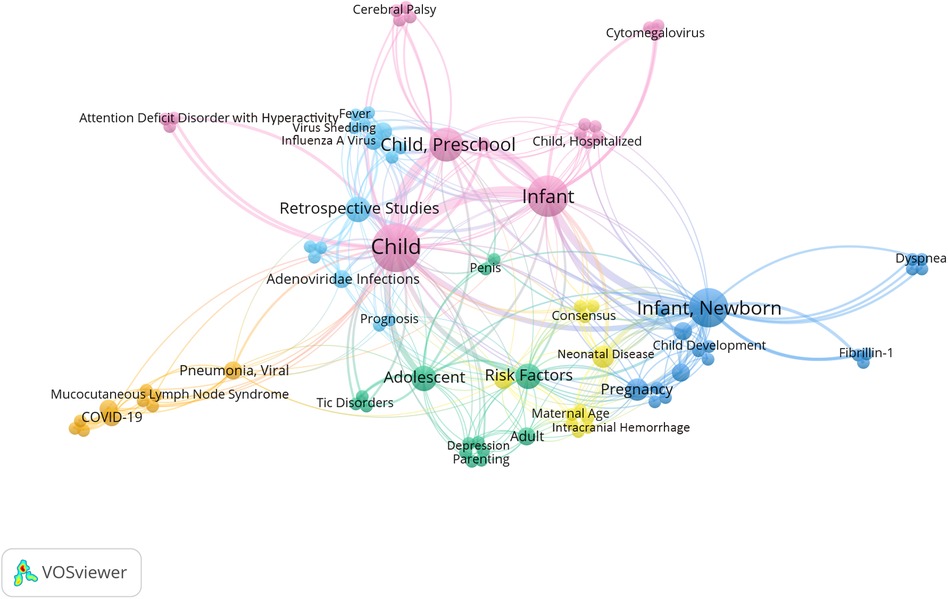
Figure 3. 2023 co-occurrence network and cluster analysis diagram of hot keywords. From the colors and clustering of the keywords in the diagram, it can be observed that there were mainly six research directions: influenza (in sky-blue); pediatric neurological disorders and neurobehavioral development (in violet-red); COVID-19 (in orange); preterm-related issues (in blue); neonatal diseases (in yellow); adolescent mental and psychological health (in blue-green).
Overall descriptive analysis of high-frequency keywords from 2021 to 2023
From the above keyword analysis, the overall trends in readership hotspots on pediatric research can be observed.
(1) COVID-19 continued to dominate readership hotspots in 2021 and 2022, spanning two years, indicating the profound impact of the COVID-19 pandemic globally and the primary focus of researchers on this topic. However, in 2023, while COVID-19 still had significant attention, influenza and other respiratory infections became the primary focus, aligning with the 2023 global focus in pediatrics. This indicates researchers’ high attention to current major public health events and hotspots in medical health, with a great demand for information on the diagnosis, treatment, prevention, and management of these diseases.
Mental health issues in children and adolescents and neurological diseases and neurodevelopment in children were consistently focused research areas in pediatrics, with increasing attention. Research on diseases in preterm infants and newborns also continued to rise, indicating urgent research needs in these areas.
Discussion
Word frequency analysis is a text mining technique that statistically analyzes the frequency of important words in literature or texts to reveal thematic content and hotspot trends, helping researchers understand which words are most critical in the texts and how these words change over time. Additionally, this study used VOSviewer to construct keyword co-occurrence networks and clustering maps. This bibliometric visualization analysis method offers more objective, intelligent, and precise advantages, reducing human interference and accurately identifying potential research hotspots (1, 2).
Through word frequency analysis and co-word analysis, this study explored the thematic types of high-readership articles from the CJCP in PMC from 2021 to 2023. Among the 1,784 articles published by the CJCP from 2016 to 2023, excluding pediatric surgery, various subspecialties in pediatrics were covered. The study results highlighted the main research directions that international researchers focus on, including (1) current major public health events and medical hotspots, such as COVID-19 and influenza; (2) mental health issues in children and adolescents; (3) pediatric neurological diseases and neurodevelopment; (4) diseases in preterm infants and newborns. This suggests that these research directions are currently and will continue to be valued and focused areas in pediatrics.
The COVID-19 pandemic has significantly impacted children's physical and mental health. This study showed that researchers concentrated on both the direct impacts of COVID-19 on children (such as infection symptoms, transmission modes, and control measures) and indirect impacts (such as the effects of isolation measures on children's psychology and behavior). Furthermore, with the promotion of vaccine inoculation, research focuses also included the effectiveness and safety of vaccines in children and adolescents. Articles related to COVID-19 had the highest readership in PMC from the CJCP in 2021 and 2022. The pandemic's peak years of 2021–2022 made COVID-19 the most focused public health event for clinical and research workers. Although attention to COVID-19 remained high in 2023, respiratory infections such as influenza became the primary focus, aligning with the global clinical focus in pediatrics in 2023. This suggests that pediatric researchers can keep pace with current major public health events or medical hotspots, sharing experiences and research findings related to these events with international peers to collectively address global pediatric health challenges. In 2023, influenza emerged as a significant topic of interest in pediatric research, particularly in the aftermath of the COVID-19 pandemic, as influenza activity gradually returned to pre-pandemic levels (3). The American Academy of Pediatrics recommends routine annual influenza vaccination for all children without medical contraindications starting at six months of age, along with the use of antiviral medications as essential strategies to mitigate influenza's impact on pediatric populations (4). Data from the 2022–2023 influenza season revealed notably high hospitalization rates for influenza among children, especially those with underlying health conditions, underscoring the severity and complexity of influenza's effects in this demographic (5). Moreover, the co-circulation of influenza with other respiratory viruses contributed to increased morbidity, highlighting the necessity for timely vaccination and treatment (3). However, many affected children were not adequately vaccinated or treated, leading to severe outcomes (5). Overall, these findings emphasize the critical importance of preventive measures and effective management strategies to protect children from influenza and its complications.
This study showed that mental health issues in children and adolescents are highly focused on by researchers worldwide, which may be due to the following reasons: (1) The rapid changes in modern social environments have increased the pressures and challenges faced by children and adolescents. Changes in family structures, school education and social competition pressures, and the widespread use of social media and the internet profoundly impact adolescents’ mental health (6–9). These factors lead to higher incidences of anxiety, depression, and behavioral problems among children and adolescents. National data from the United States in 2019 showed that among children aged 3–17, 7.1% had anxiety problems, 7.4% had behavioral problems, and 3.2% had depression (10). Meta-analysis indicated a prevalence rate of 15.4% for depressive symptoms among children and adolescents in China (11). In Hunan Province, China, the detection rates of depressive symptoms, generalized anxiety, and comorbidity of the two among middle school students in the past two weeks were 15.3%, 11.7%, and 9.0%, respectively (12). (2) Untreated mental health issues significantly affect individuals’ quality of life and impose substantial socio-economic burdens, including direct medical costs, education and productivity losses, and increased social services demand. Investing in mental health prevention and early intervention for children and adolescents can reduce long-term social and economic burdens from public health and economic perspectives.
This study indicated that pediatric neurological diseases and neurodevelopmental issues are key research areas for pediatric researchers worldwide, possibly due to the following factors: (1) Neurological diseases and neurodevelopmental disorders often have profound impacts on children's entire lives. For example, autism spectrum disorder, attention deficit hyperactivity disorder, and epilepsy not only affect children's learning and social abilities but may also persist throughout life. Early neurodevelopmental abnormalities can lead to long-term cognitive, behavioral, and social dysfunctions. Therefore, research on these diseases can improve children's short-term quality of life and reduce the long-term health burden on society. (2) Pediatric neurodevelopmental issues involve complex genetic and environmental factors, interacting to influence normal neurodevelopment. Advances in gene sequencing technology and neurobiological research now allow scientists to delve deeper into these complex biological mechanisms. These studies are crucial for developing new diagnostic methods and treatment strategies. For example, studies have shown that autism spectrum disorder is a global pediatric research hotspot (13, 14). (3) Early diagnosis and timely intervention can significantly improve prognosis for many neurological diseases. Research focuses include developing and improving early screening tools, such as using neuroimaging, biomarkers, and behavioral assessments to identify at-risk children. In addition, early intervention strategies for specific neurodevelopmental disorders, such as behavioral therapy and medication, are continuously being developed and optimized to improve patient prognosis and quality of life (15, 16). Recent systematic reviews have identified promising therapeutic strategies to improve outcomes for patients with neurological diseases. Non-pharmacological approaches—such as sensory stimulation, music therapy, virtual reality, transcranial direct current stimulation, and transcranial magnetic stimulation—show innovative potential for stimulating recovery in patients with severe brain injuries (17). Additionally, nerve growth factor has emerged as a significant therapeutic option for pediatric neurological diseases due to its ability to promote neuronal survival, repair, and plasticity. Innovative delivery methods, including intranasal administration and nanotechnology-based approaches, are being explored to enhance the effectiveness of nerve growth factor while minimizing its side effects, underscoring its potential in treating conditions like hypoxic-ischemic encephalopathy and traumatic brain injury in children (18).
This study also showed that diseases in preterm infants and newborns are key focus areas for researchers, possibly due to the following factors: (1) Preterm birth is a global critical issue, with the World Health Organization establishing November 17th as World Prematurity Day. Approximately 15 million babies are born prematurely worldwide each year, with a preterm birth rate of about 11%, and deaths due to preterm birth account for 35% of global neonatal deaths (19). Preterm infants face significant health challenges, including low vitality, immature immune systems, and high risks of chronic health issues. With increased survival rates of preterm infants, effective management of preterm sequelae and improving the quality of life of preterm infants have become important research areas. (2) Neonatal period health issues include genetic diseases, metabolic disorders, respiratory distress syndrome, and other diseases. Research in these areas aims to reduce infant mortality and improve the quality of life of surviving infants through more effective diagnosis, prevention, and treatment methods. A study based on keyword clustering analysis also found “newborns” to be a global pediatric research hotspot (14). (3) The rapid development of medical technology, particularly in genetic diagnosis, biomarkers, and monitoring equipment innovations, provides unprecedented opportunities for early diagnosis and treatment of neonatal diseases. Additionally, with social development and progress, there is increasing emphasis on the health of preterm infants and newborns. Governments and non-governmental organizations are investing more in maternal and child health projects to reduce infant mortality and improve birth quality. Research on diseases in preterm infants and newborns has long-term impacts on social and economic development.
In conclusion, this study revealed research hotspots and trends in pediatrics through word frequency analysis and co-word analysis, providing pediatric researchers with a valuable perspective to understand and grasp the development dynamics and future directions in the field of pediatrics. By exploring these hotspots, we hope to promote innovation and development in pediatrics, significantly improving children's physical and mental health and increasing international attention to researchers’ scientific achievements. While this study provides valuable insights into high readership articles within the CJCP, it is important to acknowledge that focusing exclusively on a single journal may limit the generalizability of our findings. The trends identified here may reflect specific interests and practices prevalent within the CJCP readership and may not fully capture the broader landscape of pediatric research. To gain a more comprehensive understanding of research hotspots and trends in pediatrics, future studies should consider incorporating articles from multiple journals.
Data availability statement
The original contributions presented in the study are included in the article/Supplementary Material, further inquiries can be directed to the corresponding author.
Author contributions
FD: Writing – review & editing, Writing – original draft, Validation, Project administration, Funding acquisition, Formal Analysis, Data curation, Conceptualization. WS: Writing – review & editing, Visualization, Validation, Software, Methodology, Data curation. JG: Writing – review & editing, Data curation. YY: Writing – review & editing, Conceptualization.
Funding
The author(s) declare financial support was received for the research, authorship, and/or publication of this article. This study is supported by Hunan Province Project for Cultivating World-Class Hunan Edition Scientific Journals (2023ZL6-11).
Acknowledgments
This paper employed ChatGPT 4.0 to summarize the main research directions for each year from 2021 to 2023 based on the information in Table 4. The authors referred to these summaries for their analysis. Additionally, this paper utilized ChatGPT 4.0 to refine and enhance the English language used. The authors would like to express their gratitude to ChatGPT 4.0. The authors also thank Dr. Derek Pawich (USA) for reviewing the English language of this paper.
Conflict of interest
WS was employed by Beijing Intelligent Decision Medical Technology Co., Ltd.
The remaining authors declare that the research was conducted in the absence of any commercial or financial relationships that could be construed as a potential conflict of interest.
Publisher's note
All claims expressed in this article are solely those of the authors and do not necessarily represent those of their affiliated organizations, or those of the publisher, the editors and the reviewers. Any product that may be evaluated in this article, or claim that may be made by its manufacturer, is not guaranteed or endorsed by the publisher.
References
1. Xia L, Li HW. Visualization analysis of highly cited and highly downloaded papers for medical journal topic selection strategy. Chin J Med Libr Inf Sci. (2021) 30:65–75. doi: 10.3969/j.issn.1671-3982.2021.05.010
2. Li XJ, Tang DR, Ma J, Liu ZH, Chen JY. Bibliometric analysis of the transfusion medicine research field based on PubMed database. Chin J Blood Transfus. (2020) 33(2):132–5. doi: 10.13303/j.cjbt.issn.1004-549x.2020.02.012
3. Merișescu MM, Luminos ML, Pavelescu C, Jugulete G. Clinical features and outcomes of the association of co-infections in children with laboratory-confirmed influenza during the 2022–2023 season: a Romanian perspective. Viruses. (2023) 15:2035. doi: 10.3390/v15102035
4. COMMITTEE ON INFECTIOUS DISEASES. Recommendations for prevention and control of influenza in children, 2022–2023. Pediatrics. (2022) 150:e2022059274. doi: 10.1542/peds.2022-059274
5. White EB, O'Halloran A, Sundaresan D, Gilmer M, Threlkel R, Colón A, et al. High influenza incidence and disease severity among children and adolescents aged <18 years—United States, 2022–23 season. MMWR Morb Mortal Wkly Rep. (2023) 72:1108–14. doi: 10.15585/mmwr.mm7241a2
6. Cong EC, Cai YY, Wang Y, Wu Y. Association between adolescent depression and suicidal ideation and parental rearing styles. Chin J Contemp Pediatr. (2021) 23:938–43. doi: 10.7499/j.issn.1008-8830.2105124
7. Huang XX, Li YT, Chen JH, Ma JJ, Cong EZ, Xu YF. Impact of family structure on adolescent depression and anxiety symptoms: the mediating role of emotional neglect. Chin J Contemp Pediatr. (2023) 25:80–5. doi: 10.7499/j.issn.1008-8830.2208058
8. Wang J. The relationship between parental rearing styles and anxiety and depression in elementary school students: the mediating role of academic pressure (Dissertation/master’s thesis). Tangshan: North China University of Science and Technology. (2023).
9. Chen T, Luo YL, Hu HX, Song XG, Chen FH, Fang XY, et al. Association of screen time and behavior types with anxiety and depression among middle and elementary school students in Jiangxi Province. Chin J School Health. (2024) 45:73–7. doi: 10.16835/j.cnki.1000-9817.2024077
10. Ghandour RM, Sherman LJ, Vladutiu CJ, Ali MM, Lynch SE, Bitsko RH, et al. Prevalence and treatment of depression, anxiety, and conduct problems in US children. J Pediatr. (2019) 206:256–267.e3. doi: 10.1016/j.jpeds.2018.09.021
11. Li JL, Chen X, Zhao CH, Xu Y. Meta-analysis of the prevalence of depressive symptoms in Chinese children and adolescents. Chin J Child Health Care. (2016) 24:295–8. doi: 10.11852/zgetbjzz2016-24-03-22
12. Liu RJ, Peng WJ, Zheng MX, Cheng SJ, Hu M. The current situation and epidemiological characteristics of depression and anxiety among middle school students in Hunan Province. Chin J Clin Psychol. (2023) 31:816–20. doi: 10.16128/j.cnki.1005-3611.2023.04.010
13. Fan YF, Li JH, Shan WH, Shen YM, Lian ZZ, Zang H, et al. Analysis of global research hotpots in the field of pediatrics based on essential science indicators and its revelation. Chin J Appl Clin Pediatr. (2022) 37:1756–60. doi: 10.3760/cma.j.cn101070-20220927-01121
14. Lu L, Guo YL, Dili R. ESI-based pedagogical high-cited papers. Med Inform. (2019) 32:1–4. doi: 10.3969/j.issn.1006-1959.2019.22.001
15. Chen YZ, Li N, Zhou KY. Observational study on the preventative treatment effects of behavioral therapy combined with fluoxetine on childhood migraine. Chin J Contemp Pediatr. (2014) 16:1105–8. doi: 10.7499/j.issn.1008-8830.2014.11.006
16. Di Sarno L, Curatola A, Cammisa I, Capossela L, Eftimiadi G, Gatto A, et al. Non-pharmacologic approaches to neurological stimulation in patients with severe brain injuries: a systematic review. Eur Rev Med Pharmacol Sci. (2022) 18:6856–70. doi: 10.26355/eurrev_202209_29789
17. Capossela L, Gatto A, Ferretti S, Di Sarno L, Graglia B, Massese M, et al. Multifaceted roles of nerve growth factor: a comprehensive review with a special insight into pediatric perspectives. Biology (Basel). (2024) 13:546. doi: 10.3390/biology13070546
18. LeBlanc LA, Gillis JM. Behavioral interventions for children with autism spectrum disorders. Pediatr Clin North Am. (2012) 59:147–64. doi: 10.1016/j.pcl.2011.10.006
Keywords: PubMed Central, pediatrics, research hotspots, word frequency analysis, co-word analysis
Citation: Deng F, Sun W, Guo J and Yang Y (2024) Research hotspots in pediatrics: co-word clustering analysis based on readership in PubMed Central. Front. Pediatr. 12:1460954. doi: 10.3389/fped.2024.1460954
Received: 7 July 2024; Accepted: 27 September 2024;
Published: 16 October 2024.
Edited by:
Anna Maria Musolino, Bambino Gesù Children's Hospital (IRCCS), ItalyReviewed by:
Antonio Gatto, Agostino Gemelli University Polyclinic (IRCCS), ItalyAnya Caroselli, Università Cattolica del Sacro Cuore, Italy
Copyright: © 2024 Deng, Sun, Guo and Yang. This is an open-access article distributed under the terms of the Creative Commons Attribution License (CC BY). The use, distribution or reproduction in other forums is permitted, provided the original author(s) and the copyright owner(s) are credited and that the original publication in this journal is cited, in accordance with accepted academic practice. No use, distribution or reproduction is permitted which does not comply with these terms.
*Correspondence: Fangming Deng, NDU4ODU5MDQ5QHFxLmNvbQ==
 Fangming Deng
Fangming Deng Wen Sun
Wen Sun Jiangwei Guo3
Jiangwei Guo3